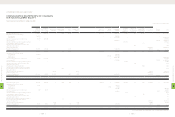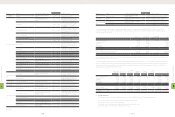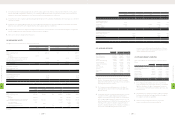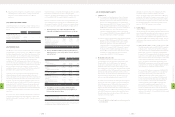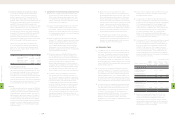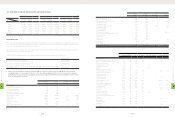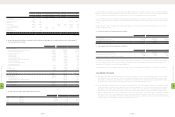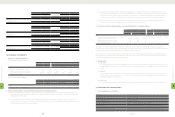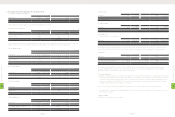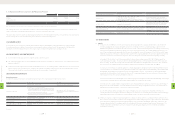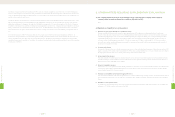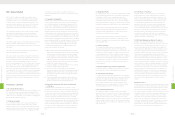HTC 2011 Annual Report Download - page 104
Download and view the complete annual report
Please find page 104 of the 2011 HTC annual report below. You can navigate through the pages in the report by either clicking on the pages listed below, or by using the keyword search tool below to find specific information within the annual report.
(6) Based on the resolutions passed by HTC's board of
directors, the employee bonuses for 2010 and 2011 should
be appropriated at 18% and 10%, respectively, of net income
before deducting employee bonus expenses. If the actual
amounts subsequently resolved by the stockholders differ
from the proposed amounts, the differences are recorded in
the year of stockholders' resolution as a change in accounting
estimate. If bonus shares are resolved to be distributed to
employees, the number of shares is determined by dividing
the amount of bonus by the closing price (after considering
the effect of cash and stock dividends) of the shares of the
day immediately preceding the stockholders' meeting.
(7) As of February 14, 2012, the date of the accompanying
independent auditors' report, the appropriation of the 2011
earnings had not been proposed by the Board of Directors.
Information on earnings appropriation can be accessed on
the Market Observation Post System website.
(22) TREASURY STOCK
1.
On February 9, 2010, the Company's board of directors passed
a resolution to buy back 15,000 thousand of its shares from the
open market. The repurchase period was between February 10,
2010 and April 9, 2010, and the repurchase price ranged from
NT$280 to NT$500 per share. If the Company's share price was
lower than this price range, the Company planned to continue to
buy back its shares. The Company bought back 15,000 thousand
shares for NT$4,834,174 thousand during the repurchase period
and retired them in April 2010.
2.
On July 11, 2010, the Company's board of directors passed a
resolution to buy back 10,000 thousand of its shares from the
open market. The repurchase period was between July 13, 2010
and September 12, 2010, and the repurchase price ranged from
NT$526 to NT$631 per share. If the Company's share price was
lower than this price range, the Company planned to continue to
buy back its shares. The Company bought back 4,786 thousand
shares for NT$2,865,990 thousand during the repurchase period.
3.
On October 29, 2010, the Company's board of directors passed
a resolution to buy back 5,000 thousand and 5,000 thousand
of its shares from the open market between November 1, 2010
and November 30, 2010, and between December 1, 2010 and
December 31, 2010, respectively, with the repurchase price
ranging from NT$565 to NT$850 per share. If the Company's
share price was lower than this price range, the Company
planned to continue to buy back its shares. The Company
bought back 5,000 thousand shares for NT$3,986,503 thousand
during these repurchase periods.
4.
In June 2011, the Company resolved to transfer 6,000 thousand
treasury shares to employees; the number of shares actually
transferred was 5,875 thousand.
5.
On July 16, 2011, the Company's board of directors passed a
resolution to buy back 10,000 thousand and 10,000 thousand of
its shares from the open market between July 18, 2011 and August
17, 2011, and between August 18, 2011 and September 17, 2011,
respectively, with the repurchase price ranging from NT$900
(US$30) to NT$1,100 (US$36) per share. If the Company's share
price was lower than this price range, the Company planned
to continue to buy back its shares. The Company bought
back 20,000 thousand shares for NT$16,086,098 thousand
(US$531,262 thousand) during the repurchase period and retired
10,000 thousand shares in December 2011.
6.
On December 20, 2011, the Company's board of directors passed
a resolution to buy back 10,000 thousand of its shares from
the open market between December 20, 2011 and February 19,
2012, with the repurchase price ranged from NT$445 (US$15)
to NT$650 (US$21) per share. If the Company's share price
becomes lower than this price range, the Company planned to
continue to buy back its shares. As of December 31, 2011, the
Company had bought back 100 thousand shares for NT$49,710
thousand (US$1,642 thousand). Other treasury stock information
for 2010 and 2011 were as follows:
(In Thousands of Shares)
Purpose of Treasury Stock
Number
of Shares,
Beginning of
Year
Addition
During
the Year
Reduction
During
the Year
Number of
Shares,
End of Year
Year ended December 31, 2010
To maintain the
Company's credibility and
stockholders' interest
- 15,000 15,000 -
For transferring shares to
the Company's employees - 9,786 - 9,786
- 24,786 15,000 9,786
Year ended December 31, 2011
To maintain the
Company's credibility and
stockholders' interest
- 10,000 10,000 -
For transferring shares to
the Company's employees 9,786 10,100 5,875 14,011
9,786 20,100 15,875 14,011
7.
Based on the Securities and Exchange Act of the ROC, the
number of reacquired shares should not exceed 10% of the
Company's issued and outstanding shares, and the total
purchase amount should not exceed the sum of the retained
earnings, additional paid-in capital in excess of par, and paid-in
capital reserve. In addition, the Company should not pledge its
treasury shares nor exercise voting rights.
(2) Treasury stock transactions and expired stock options
In June 2011, the Company resolved to transfer treasury
shares to employees. In 2011, the number of shares for
transfer to employees was 6,000 thousand, with 5,875
thousand shares exercised. Based on the fair value at the
grant date, NT$1,750,767 thousand (US$57,821 thousand) was
accounted for as capital surplus - treasury stock transactions,
and NT$37,503 thousand (US$1,239 thousand) for the
unexercised 125 thousand shares was accounted for as capital
surplus - expired stock options. Also, in December 2011, the
retirement of treasury stock caused decreases in treasury
stock transactions and expired stock options of NT$20,309
thousand (US$671 thousand) and NT$435 thousand (US$15
thousand), respectively. As a result, the treasury stock
transactions and expired stock options as of December 31,
2011 were NT$1,730,458 thousand (US$57,150 thousand) and
NT$37,068 thousand (US$1,224 thousand), respectively.
The fair values at the grant date for the fifth and sixth
stock option buyback were NT$394.105 and NT$210.121,
respectively. These fair values were estimated using the
Black-Scholes option valuation model. The inputs to the
model were as follows:
5th Buyback 6th Buyback
Assumption Exercise price (NT$) $598.83 $797.30
Expected dividend yield 3.71% 3.71%
Expected life 1.67 months 1.67 months
Expected price volatility 56.99% 56.99%
Risk-free interest rate 0.7157% 0.7157%
Fair value $394.105 $210.121
(3) Long-term equity investments
As of January 1, 2010, the capital surplus from long-term
equity-method investments was NT$18,411 thousand. When
the Company did not subscribe for the new shares issued
by an equity-method investee, Huada Digital Corporation,
in September 2011, the Company's total investment carrying
value and capital surplus decreased by NT$374 thousand
(US$12 thousand) each in 2011. As a result, the capital surplus
from long-term equity-method investments as of December
31, 2011 was NT$18,037 thousand (US$596 thousand).
(4) Merger
The additional paid-in capital from a merger was NT$25,189
thousand as of January 1, 2010. In April 2010, the retirement
of treasury stock caused a decrease of NT$479 thousand
in additional paid-in capital from a merger. As a result, the
additional paid-in capital from a merger as of December 31,
2010 was NT$24,710 thousand. Also, in December 2011, the
retirement of treasury stock caused a decrease of NT$287
thousand (US$9 thousand) in additional paid-in capital from
a merger. As a result, the additional paid-in capital from a
merger as of December 31, 2011 was NT$24,423 thousand
(US$807 thousand).
4. Appropriation of Retained Earnings and Dividend Policy
(1) Based on the Company Law of the ROC and HTC's Articles
of Incorporation, 10% of HTC's annual net income less any
deficit should first be appropriated as legal reserve. From
the remainder, there should be appropriations of not more
than 3 as remuneration to directors and supervisors and
at least 5% as bonuses to employees.
(2) Legal reserve shall be appropriated until it has reached the
Company's paid-in capital. This reserve may be used to
offset a deficit. Under the revised Company Law issued on
January 4, 2012, when the legal reserve has exceeded 25% of
the Company's paid-in capital, the excess may be transferred
to capital or distributed in cash.
(3) As part of a high-technology industry and as a growing
enterprise, HTC considers its operating environment, industry
developments, and long-term interests of stockholders as
well as its programs to maintain operating efficiency and
meet its capital expenditure budget and financial goals in
determining the stock or cash dividends to be paid. HTC's
dividend policy stipulates that at least 50% of total dividends
may be distributed as cash dividends.
(4) The bonus to employees of NT$4,859,236 thousand for
2009 was approved in the stockholders' meeting in June
2010. The bonus to employees consisted of a cash bonus of
NT$2,915,542 thousand and a share bonus of NT$1,943,694
thousand. The share number of 5,021 thousand was
determined by dividing the amount of share bonus by the
closing price (after considering the effect of cash and stock
dividends) of the shares of the day immediately preceding
the stockholders' meeting. The approved amounts of the
bonus to employees were the same as the accrued amounts.
(5) The bonus to employees of NT$8,491,704 thousand for
2010 was approved in the stockholders' meeting in June
2011. The bonus to employees consisted of a cash bonus of
NT$4,245,852 thousand and a share bonus of NT$4,245,852
thousand (The amounts were NT$4,245,853 thousand
and NT$4,245,851 thousand, respectively, after taking into
account the effect that the amount less than one share will
be distributed in the form of cash). The share number of
4,006 thousand was determined by dividing the amount
of share bonus by the closing price (after considering the
effect of cash and stock dividends) of the shares of the day
immediately preceding the stockholders' meeting. The
approved amounts of the bonus to employees were the same
as the accrued amounts.
8
FINANCIAL INFORMATION
| 204 |
8
FINANCIAL INFORMATION
| 205 |


